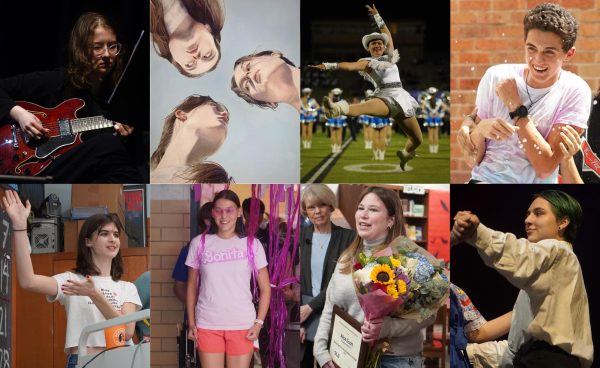A très compliqué year for advanced French students
Mixed-level classes force Favrin to teach three levels simultaneously
French 3 students work independently on vocabulary practice during class time. With Favrin busy instructing French 4 and 5 students, they must manage their time and assignments and continue to develop their French skills on their own.
C’est la vie, or “that’s life” is one of the best ways to describe how French teacher Charlotte Favrin and her students are feeling about this school year. Due to an unexpected increase in French students and limited scheduling options, the administration formed mixed-level classes with all three upper level French classes combined.
“I was surprised about it,” Favrin said. “I’ve never done that before, I’ve never had that mix before, so I felt it was a challenge for sure.”
McCallum offers up to five levels of French, each with varying curriculas and difficulty. Since Favrin is the singular French teacher, the responsibility falls to her to teach every level, three of which during the same class period.
“I’m hoping we can have a culture in the class of independent practice,” Favrin said. “You get a task, you work by yourself and then at the end of class or at the beginning or next class I will work with you specifically. I cannot cut myself in three and work with everybody at the same time.”
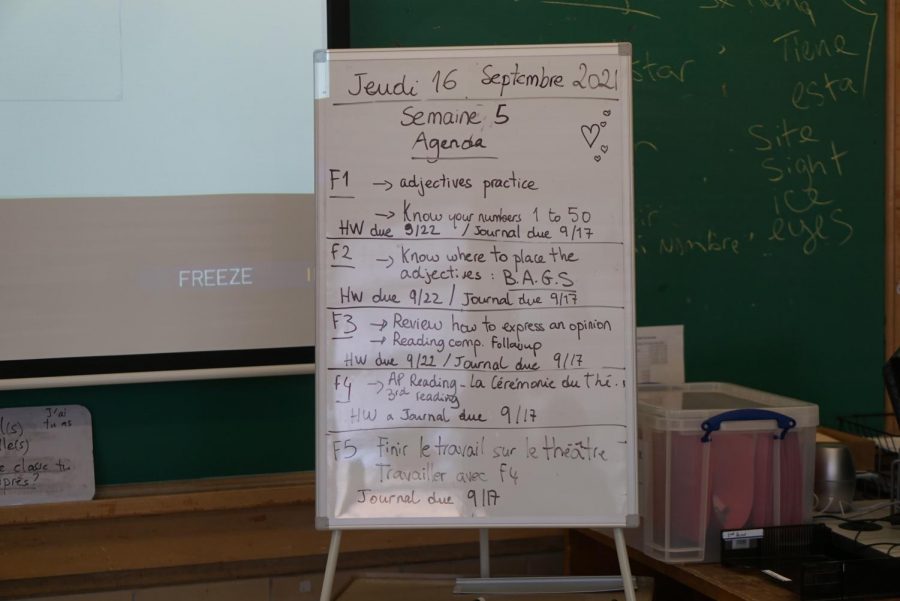
The three upper levels each have extremely different curriculums. French 3 is a transition year from base-level French to more advanced learning, focusing on deeper themes but still touching on basic mechanics such as verb conjugation. French 4 follows the AP curriculum to prepare for the exam, with students focusing more on debate and developing ideas one hundred percent in French. French 5 studies French history and literature, with focus on summary and analysis.
For Favrin, the challenge is making sure the students of each level of French learn what they need to without the class being too challenging, or, for the advanced students, not challenging enough.
“I’m not freaking out, I have a plan, but I can see it’s gonna take some adjustment and maybe some frustration,” Favrin said. “So this is what I’m always worried about: my students being frustrated, like the advanced students being frustrated because it doesn’t move fast enough and then the lower students being frustrated because it’s too hard. So I really want to make sure that everybody has their needs met at their level.”
I cannot cut myself in three and work with everybody at the same time.
— French teacher Charlotte Favrin
The required amount of time to earn language credits is two years, so there is generally a large dropoff in numbers after French 2. Stacked classes, or classes with multiple levels of a similar curriculum combined to make a larger class, was the result of an unexpectedly large French 3 enrollment for the 21-22 school year. French as a whole has shown growth: Favrin taught around 80 students last year, while this year the number is closer to 130.
“This year, we’ll credit Ms. Favrin for that,” Assistant Principal Andy Baxa said. “Ms. Favrin has brought a new passion to French, and students are more engaged and interested in the class. And so that’s resulting in higher numbers within French.”
As native Parisian and French speaker, Favin is one of the most experienced French teachers McCallum students could learn from. According to her students, this authenticity is part of what makes her so valuable as a teacher.
“It’s good that she’s from France,” Sophomore and French 4 student Edie Birkholz said. “and has a good accent.”
I’m always very excited when you guys want to learn my language, because it’s my language, my culture. I feel proud that you guys had those options and you’re like, ‘No, no, français! I want to learn French.’
— Charlotte Favrin
Only truly motivated students follow French through to the end, so there are less than twenty total French 4 and 5 students. Stacking classes also gives more students a chance to take the class; without it, there would have been only one period of French 5, which would have limited the opportunity for students at that level to continue French.
While Ms. Favrin feels up to the challenge, students have mixed opinions. Birkholz was apprehensive about being in a mixed-level class.
“It’s hard because French 4 is supposed to be all in,” Birkholz said. “You’re immersed in the language but when you’re sharing a classroom with French 3, it’s impossible to be immersed in the language, because French 3 uses English. And I feel like a lot of the lessons are just gonna be teaching the same thing as French 3. So it feels like I’m not gonna be prepared for the AP test.”
But while three simultaneous classes is certainly a challenge, other students are more optimistic.
“I saw the students from French 4 and 5 and they were speaking fluently,” Freshman and French 3 student Finley Dixon said. “And I was like, ‘Oh, I cannot do that.’ I think there will be a little bit of a higher expectation than if we were just in French 3. But… It’s actually been really good. And I enjoy hearing the French 5 students and Ms. Favrin talk to each other. It’s really cool.”
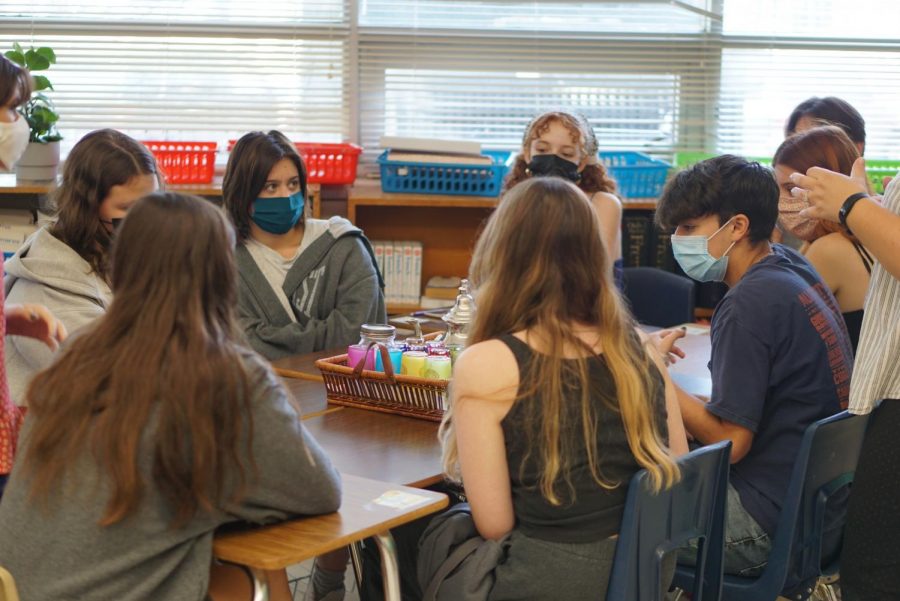
Senior and French 5 student Kenta Asazu also sees the benefits.
“I think a positive thing would be… we could help with other people’s work as well,” Asazu said. “There’s no challenges whatsoever from my point of view for being in a French 3, 4, 5 class. You get to see yourself two years ago, which is pretty cool. And if it was just French 5, it would only be three people, which would be lonely, so I’m glad it’s a mixed level class.”
Mixed-level classes are only a temporary solution to a possibly long-term problem. If French continues to grow, the administration may have to examine other options, such as having a second French teacher. This would make life easier for Favrin. Despite the difficulties, however, she is excited to have so many people interested in French.
“I’m always very excited when you guys want to learn my language, because it’s my language, my culture,” Favrin said. “It makes me feel good. I feel proud that you guys had those options and you’re like, ‘No, no, français! I want to learn French.’ This is kind of the best part of my job because I’m teaching something that people want to learn, I’m not forcing it.”



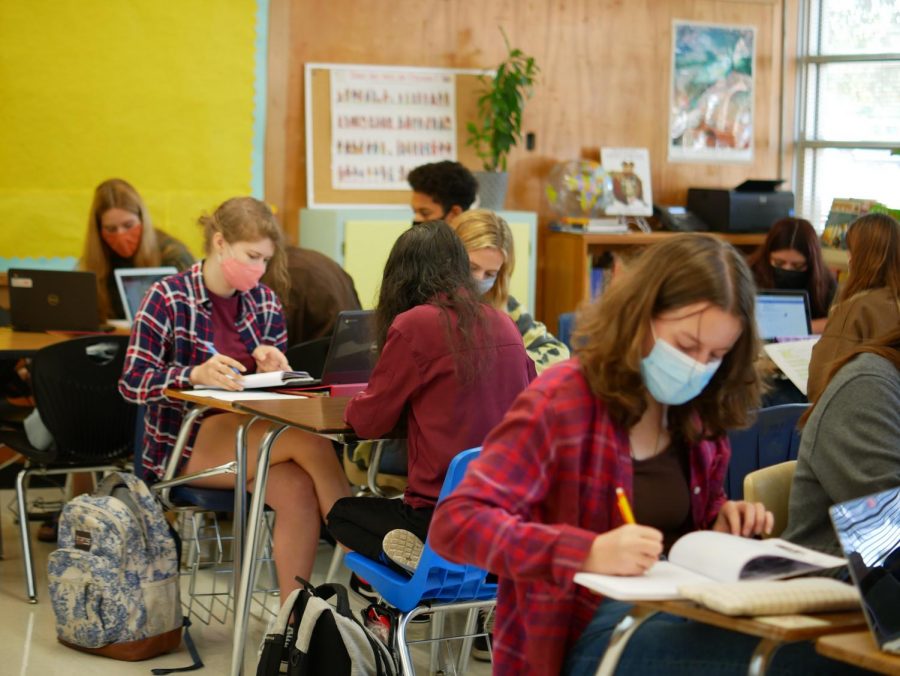


![CROWDSOURCING: Arwen Frederiksen (far left) walks down the hallway before school starts to re-familiarize themselves with the campus. “[The hallways] were definitely busier than I expected,” Frederiksen said. After almost a year and a half of virtual learning, Frederiksen expresses how they are simply happy to be around other people once again. “I haven’t seen a bunch of my just school friends in forever,” Frederiksen said. “It was great.” Reporting by Alysa Spiro.](https://macshieldonline.com/wp-content/uploads/2021/08/03-Alysa-475x316.jpg)



![CROWDSOURCING: Arwen Frederiksen (far left) walks down the hallway before school starts to re-familiarize themselves with the campus. “[The hallways] were definitely busier than I expected,” Frederiksen said. After almost a year and a half of virtual learning, Frederiksen expresses how they are simply happy to be around other people once again. “I haven’t seen a bunch of my just school friends in forever,” Frederiksen said. “It was great.” Reporting by Alysa Spiro.](https://macshieldonline.com/wp-content/uploads/2021/08/03-Alysa-300x199.jpg)

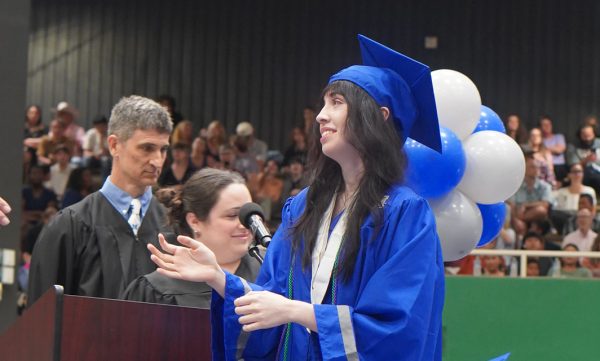



![This is Paul Pews high school graduation photo. The 2023-2024 school year marked his 34th year of teaching. He began his career in Washington, then came to McCallum where he has taught for the past 17. At heart though, he’s really a musician. One that grew up in many different places, including Chicago and California, who took interest in teaching from a young age. His high school choir experience, along with some international singing in college, persuaded him that teaching was his path. He knew he wanted to be able to help create works of art in the fine arts department as well, so he joined McCallum. He’s worked on many of the musicals over the years, even before Joshua Denning, the former theatre director of the fine arts program arrived. Before him was a different director: Tatum.
“I was the music director for all the musicals,” Pew said. “[Mr. Tatum and I] worked very hard, and I just got to the point where I was satisfied with it.” Although he may not be as prominent of a member in the musical theatre community at McCallum anymore, he still plays piano. “I still do a lot of music down at the Music end of the building,” Pew said. Photo courtesy of Paul Pew.](https://macshieldonline.com/wp-content/uploads/2024/07/Paul-Pew-1974-444x600.jpg)

![DANCING QUEEN ONLY 15: The Mccallum quinceañera took place Saturday May 18 in the cafeteria. Students who danced at the quinceañera practiced for weeks during lunch and after school with the help of Señora A to perfect this special moment. “I signed up for fun and for the dress originally, but I actually made a lot of friends, and it helped me want to come back to practice,” said Elizabeth Peables, a freshman quinceñeara. “It’s been stressful, but it always works. We stayed very late yesterday [the day before the event], but today it feels like everything came together.”
Caption by Nellie Eschberger with reporting by Beatrix Lozach.
LA REINA DE BAILE, SOLAMENTE TIENE 15 AÑOS DE EDAD: La Quinceñera de McCallum fue el 18 de Mayo en la cafetería. Estudiantes que bailaron en la quinceañera practicaron por semanas durante el almuerzo y después de la escuela con la ayuda de la Sra. A para perfeccionar este momento especial.
“Originalmente me inscribí para divertirme, y por el vestido, pero actualmente hice muchos amigos y me ayudó a querer regresar a la práctica.” Dijo la estudiante de primer año Elizabeth Peables. “Ha sido muy estresante, pero siempre funciona.” “Nos quedamos muy tarde ayer el día antes del evento pero hoy se siente que todo está cayendo en forma.”
Leyenda por Nellie Eschberger con reportaje de Beatrix Lozach. Traducción por Maverick Palacios.](https://macshieldonline.com/wp-content/uploads/2024/06/53732328578_3ee2526f55_o_53769409497_o-600x338.jpg)
